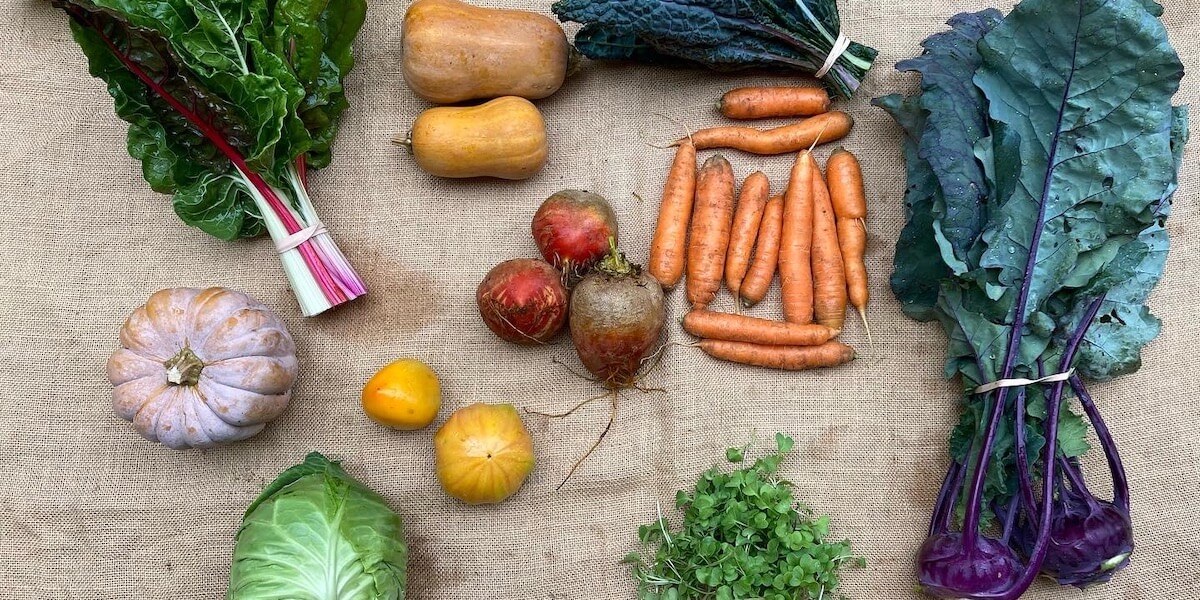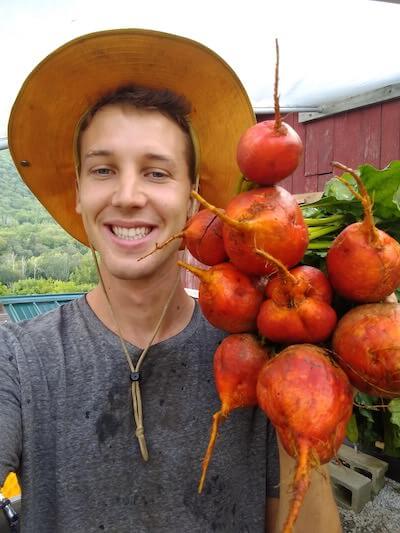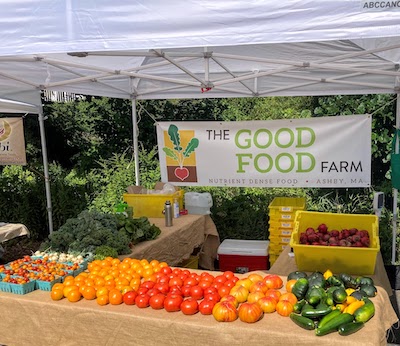
USC Viterbi alumnus Andrew Johnson grows a wide variety of nutrient-dense produce on The Good Food Farm in Massachusetts (Photo/Courtesy of Andrew Johnson)
In Bill Bryson’s national bestseller “The Body,” he notes the bizarre paradox of American food.
“We are essentially the world’s most overfed nation,” he writes, “but also one of its most nutritionally deficient.”
Indeed, modern fruits, vegetables, and grains grown today “carry less protein, calcium, phosphorus, iron, riboflavin, and vitamin C” than those that were grown mere decades ago.
Not if Andrew Johnson (B.S. ISE ’19) can help it.
For this USC Viterbi alumnus, the knowledge he acquired as a graduate student in the Daniel J. Epstein Department of Industrial and Systems Engineering has translated into his current work developing nutrient-dense and sustainable food.

Andrew Johnson (Photo/Courtesy of Andrew Johnson)
In November 2021, Johnson partnered with entrepreneurs Dick and Patty Simon to establish The Good Food Farm in Ashby, Massachusetts. On just one acre, Johnson and his crew grow a diverse variety of crops, ranging from heirloom tomatoes to unique squash varieties bred for their taste. The farm distributes produce in the greater Boston area, primarily focusing on direct to consumer sales. Customers receive weekly shipments that include crops in quantities that best serve their needs.
This unique approach to agriculture, which closes the gap between production and consumption, is aptly called community supported agriculture. Johnson’s goal: leverage techniques of systems engineering to grow the most nutrient-dense food possible while simultaneously operating efficiently to keep costs down.
“Plants are highly complex organisms,” Johnson said. “There’s so much research to be done. We’re still learning how to develop the healthiest food and are committed to doing just that.”
Johnson shatters the notion that farming is an old-fashioned, low-tech practice. He works on the nexus of engineering and agriculture to produce rich nutrient density and a high crop yield.
For instance, Johnson and his team employ data analyses to improve their understanding of yield and profitability. Johnson also conducts time and motion studies to increase efficiency during the harvest and wash process. Resulting simulations help to make accurate predictions about labor costs associated with producing different vegetables. They also inform him of factors which, when changed, might optimize operating procedures. By incorporating these practices – and a multitude of others such as cover crops, minimal tillage, raised beds, intensive crop spacing, crop rotation, and compost teas – Johnson can optimize crop nutrient density and output.
The impetus for his farm’s focus on soil health is based on a growing body of research led by the Bionutrient Food Association in Massachusetts, which has found a significant variance in the nutrient level of vegetables depending on the quality of the soil in which they are grown.
For example, one head of lettuce grown in healthy soils can have up to seven times more nutrients than another of the exact same variety grown in degraded soils. Johnson said that’s why he and his team work so hard to optimize soil health metrics. In keeping with his emphasis on healthy foods, he uses no chemical pesticides or synthetic fertilizers.
“It’s really about nourishing consumers and directly connecting them to where their food comes from,” Johnson said. “You can go to Whole Foods and buy organic vegetables, but you know so little about where those vegetable came from and who was involved in growing them. When you buy vegetables from a farm like ours, you’re not just conceiving an abstract idea of a farm somewhere. You’re thinking, ‘I know who grew this.”‘
A country boy
Johnson was born in Fairmont, Minnesota, a slice of rural America where acres of crops line highways, corn crowds fields, and the stench of manure penetrates the air. Many Fairmont residents make their living farming, including members of Johnson’s extended family. That said, the industrial mono-cropping type of agriculture so prolific in the Midwestern United States never particularly appealed to him.

Some of the fruits and vegetables for sale at The Good Food Farm (Photo/Courtesy of Andrew Johnson)
Instead, Johnson went to the USC Viterbi School of Engineering with the intention of working in aerospace. However, after writing a paper about food systems in a class (ISE 370 Human Factors) taught by USC Viterbi Professor Najmedin Meshkati, Johnson discovered his passion for food systems. His report analyzed food security and specifically addressed food deserts: areas where residents have little access to affordable and healthy foods.
“Andrew was one of the most dedicated, responsible, engaged students I have met in my professional career,” Meshkati said. “His passion and aspiration to do something good for humanity always reminded me of a quote by Horace Mann: ‘Be ashamed to die until you have won some victory for humanity.’”
Despite his newfound interest in food systems, Johnson continued on his path toward work in the aerospace sector. He landed a job at NASA’s Jet Propulsion Laboratory. However, between graduation and JPL, he spent three months over the summer on a small, no-till farm in Michigan. He said he found the work quite rewarding.
Still, Johnson decided to pursue a more lucrative career in aerospace – at least for a while. However, this “dream job” for many left Johnson feeling dissatisfied. “My heart was somewhere else. Quality assurance did not involve a lot of creativity for me,” he said. “The nice thing about working on a farm is that I get to wear a lot of hats. I get to interact with customers, train employees, be outside and feel connected to the place I’m living.”
Back to the Farm
When the pandemic hit, he decided he decided to leave aerospace altogether and focus on a career in agriculture. After working on several different farms and gaining some skills as a grower, he landed in Ashby, Massachusetts, where he started The Good Food Farm.
Looking forward, Johnson wants to be able to grow nutrient-dense food for a lot more people. He envisions The Good Food Farm being integrated into a larger network of producers that takes advantage of economies of scale, shared infrastructure, synergistic enterprises, and wholesale food distribution networks. A cooperative of producers, he believes, is what it is going to take for sustainable, local, nutrient dense farming to get to the point where it makes a substantial dent in the food system. Along this journey, the lessons and skills he learned as a student at USC Viterbi will always be with him.
“I see industrial systems engineering as a toolkit,” he said.
Published on March 15th, 2023
Last updated on March 15th, 2023











